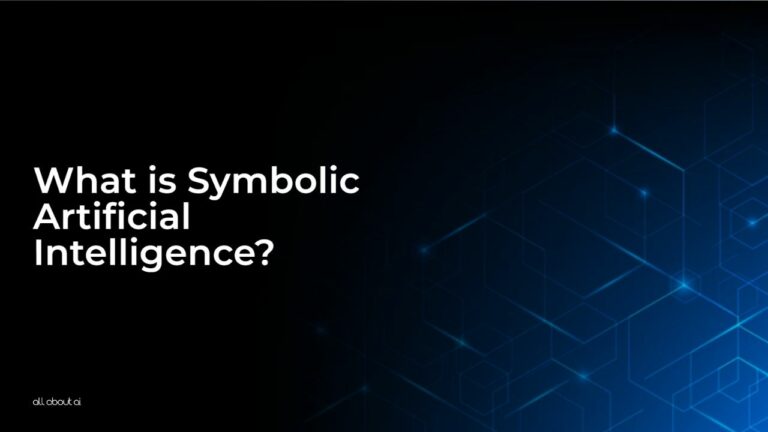What is Symbolic Artificial Intelligence (AI)? Also known as rule-based or logic-based AI, it represents a foundational approach in the field of artificial intelligence. This method involves using symbols to represent objects and their relationships, enabling machines to simulate human reasoning and decision-making processes.
Looking to learn more about this concept? Keep reading this article written by the AI professionals at All About AI.
What is Symbolic Artificial Intelligence?: Robots with Rules
Symbolic Artificial Intelligence, or AI for short, is like a really smart robot that follows a bunch of rules to solve problems. Think of it like playing a game where you have to follow certain rules to win. In Symbolic AI, we teach the computer lots of rules and how to use them to figure things out, just like you learn rules in school to solve math problems. This way of using rules in AI has been around for a long time and is really important for understanding how computers can be smart.
Core Concepts of Symbolic AI:
At the heart of Symbolic AI lie key concepts such as Logic Programming, Knowledge Representation, and Rule-Based AI. These elements work together to form the building blocks of Symbolic AI systems.

Logic Programming and Symbolic AI:
Logic Programming, a vital concept in Symbolic AI, integrates Logic Systems and AI algorithms. It represents problems using relations, rules, and facts, providing a foundation for AI reasoning and decision-making, a core aspect of Cognitive Computing.
Knowledge Representation:
In Symbolic AI, Knowledge Representation is essential for storing and manipulating information. It is crucial in areas like AI History and development, where representing complex AI Research and AI Applications accurately is vital.
Rule-Based AI:
Rule-Based AI, a cornerstone of Symbolic AI, involves creating AI systems that apply predefined rules. This concept is fundamental in AI Research Labs and universities, contributing to significant Development Milestones in AI.
Comparison with Neural Networks:
Contrasting Symbolic AI with Neural Networks offers insights into the diverse approaches within AI.
Neural Networks excel in learning from data, handling ambiguity, and flexibility, while Symbolic AI offers greater explainability and functions effectively with less data.
Approach to Learning:
Symbolic AI’s logic-based approach contrasts with Neural Networks, which are pivotal in Deep Learning and Machine Learning. Neural Networks learn from data patterns, evolving through AI Research and applications.
Handling Ambiguity:
Neural Networks, compared to Symbolic AI, excel in handling ambiguous data, a key area in AI Research and applications involving complex datasets.
Explainability:
Symbolic AI, known for its clear logic, offers greater explainability than Neural Networks. This transparency is crucial for AI researchers and software engineers focusing on Explainable AI.
Data Dependency:
Neural Networks’ dependency on extensive data sets differs from Symbolic AI’s effective function with limited data, a factor crucial in AI Research Labs and AI Applications.
Flexibility in Learning:
Neural Networks display greater learning flexibility, a contrast to Symbolic AI’s reliance on predefined rules. This difference is a key focus in AI Research and development.
Real-World Applications of Symbolic AI:
Symbolic AI has numerous applications, from Cognitive Computing in healthcare to AI Research in academia. Its ability to process complex rules and logic makes it ideal for fields requiring precision and explainability, such as legal and financial domains.

Expert Systems in Healthcare:
Expert Systems, a significant application of Symbolic AI, demonstrate its effectiveness in healthcare, a field where AI Applications are increasingly prominent.
Financial Fraud Detection:
Symbolic AI’s application in financial fraud detection showcases its ability to process complex AI algorithms and logic systems, crucial in AI Research and AI Applications.
Legal Advisory Systems:
In legal advisory, Symbolic AI applies its rule-based approach, reflecting the importance of Knowledge Representation and Rule-Based AI in practical applications.
Customer Service Chatbots:
Symbolic AI-driven chatbots exemplify the application of AI algorithms in customer service, showcasing the integration of AI Research findings into real-world AI Applications.
Industrial Automation:
Symbolic AI’s role in industrial automation highlights its practical application in AI Research and AI Applications, where precise rule-based processes are essential.
Benefits of Symbolic AI:
Symbolic AI offers clear advantages, including its ability to handle complex logic systems and provide explainable AI decisions.
- Explainable Outcomes: Ideal for industries requiring transparency, crucial for AI researchers focusing on Explainable AI.
- Effectiveness with Limited Data: Works well with less data, a significant factor in AI Research Labs.
- Precise Rule-Based Decisions: Offers precision, essential in AI Applications where strict rules are paramount.
- Ease of Knowledge Transfer: Facilitates easy modification of AI algorithms through rule changes.
- Strong Performance in Specific Domains: Excels in areas with well-defined rules, a focus in AI Research.
- Reliability in Stable Environments: Remains reliable in environments with consistent rules, important in AI Applications.
Limitations and Challenges of Symbolic AI:
Despite its strengths, Symbolic AI faces challenges, such as the difficulty in encoding all-encompassing knowledge and rules, and the limitations in handling unstructured data, unlike AI models based on Neural Networks and Machine Learning.
- Encoding Complexity: Encoding human knowledge into rules is challenging, a key concern in AI History and AI Research.
- Handling Ambiguous Data: Struggles with ambiguous data, unlike neural networks, a focus in Machine Learning and Deep Learning.
- Limited Learning Capability: Lacks data-driven learning capability, a contrast to Neural Networks and Deep Learning.
- Scalability Issues: Scaling Symbolic AI systems is resource-intensive, a significant factor in AI Research Labs.
- Rigidity in Application: The strict rule application can limit flexibility, a concern in evolving AI Applications.
- Maintenance Complexity: Maintaining rule bases is cumbersome as AI Research and AI Applications evolve.
The Future of Symbolic AI:
Looking ahead, Symbolic AI’s role in the broader AI landscape remains significant. Ongoing research and development milestones in AI, particularly in integrating Symbolic AI with other AI algorithms like neural networks, continue to expand its capabilities and applications.

Integration with Machine Learning:
The future includes integrating Symbolic AI with Machine Learning, enhancing AI algorithms and applications, a key area in AI Research and Development Milestones in AI.
Advancements in Knowledge Representation:
Improvements in Knowledge Representation will boost Symbolic AI’s modeling capabilities, a focus in AI History and AI Research Labs.
Enhanced Natural Language Processing:
Symbolic AI will advance Natural Language Processing, a crucial aspect of Cognitive Computing and AI Applications.
Expansion in Healthcare Applications:
Symbolic AI’s growing role in healthcare reflects the integration of AI Research findings into practical AI Applications.
Ethical AI and Regulatory Compliance:
The rule-based nature of Symbolic AI aligns with the increasing focus on ethical AI and compliance, essential in AI Research and AI Applications.
Want to Read More? Explore These AI Glossaries!
Embark on a journey into the realm of artificial intelligence through our meticulously designed glossaries. Whether you’re a newcomer or an adept, there’s always something novel to uncover!
- What is Backpropagation Through Time?: Backpropagation through time is a variant of the standard backpropagation algorithm, tailored specifically for Recurrent Neural Networks (RNNs).
- What is Backward Chaining?: Backward chaining is an inference method where an AI system starts with a goal or desired outcome and works backward through a series of rules and conditions to find the necessary steps or conditions to achieve that goal.
- What is the Bag of Words Model?: It is a simplistic yet powerful approach in artificial intelligence, particularly in natural language processing (NLP).
- What is Batch Normalization?: Batch normalization is an essential technique in artificial intelligence, particularly in neural network training.
- What is the Bees Algorithm?: It is a nature-inspired computing technique, mirroring the food foraging behavior of honey bees.
FAQs
What is an example of symbolic artificial intelligence?
What is the difference between symbolic AI and connectionist AI?
Is symbolic AI still relevant?
What is the best language for symbolic AI?
Conclusion:
Symbolic Artificial Intelligence continues to be a vital part of AI research and applications. Its ability to process and apply complex sets of rules and logic makes it indispensable in various domains, complementing other AI methodologies like Machine Learning and Deep Learning.
This article was written to answer the question, “what is symbolic artificial intelligence.” Looking to enhance your understanding of the world of AI? Read through the rest of the articles in our AI Definitions Index.





